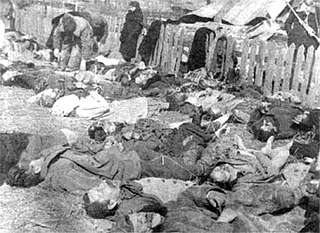Dovhyi Voinyliv
Dovhyi Voinyliv (Ukrainian: Довґий Войнилів, Polish: Dołha Wojniłowska) is a village in Kaluskyi Raion, Ivano-Frankivsk Oblast, Ukraine. Before World War II the village was part of Kałusz county in Stanisławów Voivodship, Second Republic of Poland.[1]
Dovhyi Voinyliv | |
|---|---|
Village | |
 Dovhyi Voinyliv Location of Dovhyi Voinyliv within Ukraine | |
| Coordinates: 49°9′N 24°22′E | |
| Country | |
| Oblast | Ivano-Frankivsk Oblast |
| Raion | Kaluskyi Raion |
World War II
During the wave of massacres of Poles in Volhynia between 1942 and 1945, Dołha Wojniłowska was one of hundreds of sites of mass murder of Polish civilians by OUN-UPA.[2] On April 2, 1944 local Catholic priest, Rev. Błażej Czuba,[3] was burned alive in his parish with 85 people. Soon after, on the first night of Easter, April 9–10, 1944, additional 64 people were massacred there during an OUN-UPA murderous raid overlooked by SS-Galizien. The attack was accompanied by the burning and razing of farmhouses, schools and churches.[4]
Sources
- Volhynia Gazetteer. Location according to SGGEE guideline.
- Stanisław Jastrzębski, Ludobójstwo ludności polskiej przez OUN-UPA w województwie stanisławowskim w latach 1939-1946. Compilation of data. See also: Iwona Łaptaszyńska, Recorded names of victims from Dołha Wojniłowska. Stankiewicze.com.
- Kluby Gazety Polskiej, redaktor naczelny Tomasz Sakiewicz, Ze wzgórza pod Krakowem Archived October 6, 2011, at the Wayback Machine
- Grzegorz Hryciuk, Galicja Wschodnia i Wolyn w latach 1941-1944 Archived 2011-05-24 at the Wayback Machine Chapter 5. Likwidacja tzw. gett wtórnych. Liczba ofiar Holocaustu w Galicji Wschodniej
- Grzegorz Hryciuk, Holocaust in Eastern Galicia 1941-1944. (in Polish)
